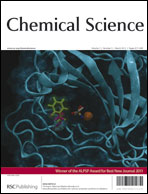In order to gain insight into the mechanism for the thermal ring-opening polymerization of strained dicarba[2]ferrocenophanes, the thermal reactivity of selected examples of these species with different substitution patterns has been explored. When heated at 300 °C dicarba[2]ferrocenophanes meso/rac-[Fe(η5-C5H4)2(CHPh)2] (mesomeso/racrac-7) and meso-[Fe(η5-C5H4)2(CHCy)2] (mesomeso-13) were found to isomerize or to undergo disproportionation, respectively. These processes are apparently general for dicarba[2]ferrocenophanes with one or more non-hydrogen substituents at each carbon atom in the dicarba bridge and both appear to involve homolytic cleavage of the C–C bond in the bridge as a key step. In striking contrast, derivatives containing either one or no non-hydrogen substituents on the bridge such as {Fe[η5-C5H4]2[CH(Ph)CH2]} (15) and [Fe(η5-C5H4)2(CH2)2] (17) undergo thermal ring-opening polymerization (ROP) under similar conditions (300 °C, 1 h). Thus, thermolysis of 15 yielded polyferrocenylethylene {Fe[η5-C5H4]2[CH(Ph)CH2]}n (16a) with a broad molecular weight distribution (Mw = 13,760, PDI = 3.27). Analysis of 16a by MALDI-TOF mass spectrometry suggested that the material was macrocyclic. Thermal treatment of linear polyferrocenylethylenes {Fe[η5-C5H4]2[CH(Ph)CH2]}n with narrow molecular weight distributions (prepared by photocontrolled ROP) at 300 °C confirmed that the macrocycles detected form directly, and not as a result of depolymerization. Copolymerizations of 15 with 17 and of 15 with the deuterated species [Fe(η5-C5H4)2(CD2)2] (dd44-17) were conducted in order to probe the bond cleavage mechanism. Comparative NMR spectroscopic analysis of the resulting copolymers 18 and dd44-18, respectively, and of homopolymer 16a, indicated that thermal ROP does not occur via a homolytic C–C bridge cleavage mechanism. A series of thermolysis experiments were conducted with MgCp2 (Cp = η5-C5H5) at 300 °C, which resulted in the isolation of ring-opened species formed from 15 and 17, and indicated that the Fe–Cp bonds can be cleaved under the thermal ROP conditions employed. The studies indicated that a chain growth process that involves heterolytic Fe–Cp bond cleavage in the monomers is the most probable mechanism for the thermal ROP of dicarba[2]ferrocenophanes.
![Graphical abstract: An iron-cyclopentadienyl bond cleavage mechanism for the thermal ring-opening polymerization of dicarba[2]ferrocenophanes](/en/Image/Get?imageInfo.ImageType=GA&imageInfo.ImageIdentifier.ManuscriptID=C1SC00566A&imageInfo.ImageIdentifier.Year=2012)
You have access to this article
 Please wait while we load your content...
Something went wrong. Try again?
Please wait while we load your content...
Something went wrong. Try again?
![Graphical abstract: An iron-cyclopentadienyl bond cleavage mechanism for the thermal ring-opening polymerization of dicarba[2]ferrocenophanes](/en/Image/Get?imageInfo.ImageType=GA&imageInfo.ImageIdentifier.ManuscriptID=C1SC00566A&imageInfo.ImageIdentifier.Year=2012)

 Please wait while we load your content...
Please wait while we load your content...